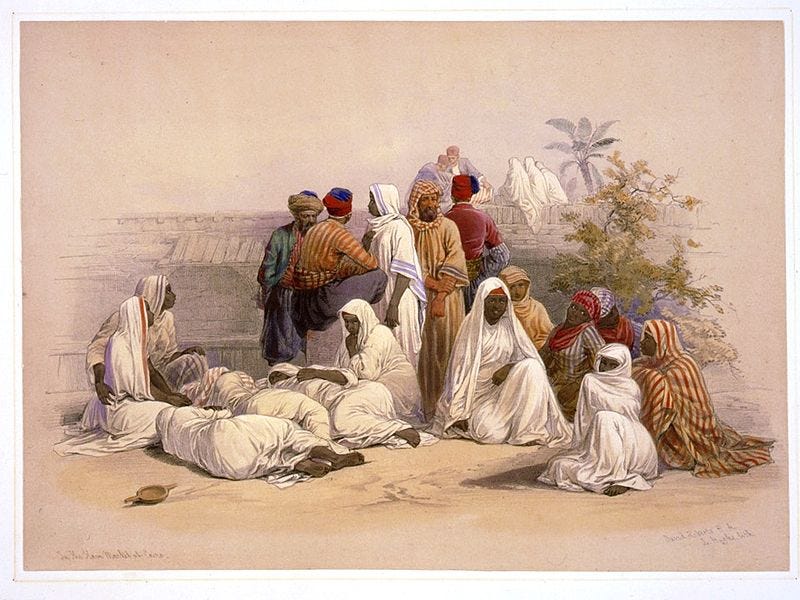Review of Ronald Segal's "Islam's Black Slaves." (2001)
Ronald Segal, Islam’s Black Slaves: The Other Black Diaspora (New York: Farrar, Straus, and Giroux, 2001), pgs. 273.

Jewish South African writer and anti-apartheid activist Ronald Segal (1932-2008) wrote The Black Diaspora (1995) and suggested in that book that future scholars would need to cover the slave trade into Islamic nations during the last four hundred years. According to his preface he was persuaded to tackle this thorny issue by his readers and as a result began pursuing the history of the African slave trade into the Middle East. This is a fascinating topic and one that is often overlooked by scholars in Euro-American history. While Segal is a dynamic writer, there are areas that remain inadequately explained or that did not have sufficient context to be convincing.
Several major themes are found throughout Islam’s Black Slaves. First, the idea that Islamic slavery was more benign is a prominent theme from chapter to chapter. Second, economics, specifically capitalism, are the roots of greater brutality and violence within slavery. Finally, slavery and its brutality are antithemical to Islam (and to Christianity) and thus those who practiced slavery are inherently not true followers of their religion. Segal’s narrative covers from the formation of Islam under the guidance of the Prophet Mohammad till the twentieth century.
Segal has several strengths that made this book fascinating. First, the breadth of his study allow for the reader to see the expansiveness of the African slave trade. Moving far beyond the ports of the Mediterranean to as far as China and India, Segal traces the global slave trading routes that led to a wide Black diaspora. Framing the African diaspora beyond the Atlantic world is something that I am unaccustomed to as an Early American scholar. However, the insight into this broader diaspora helped me to think more critically about Atlantic world slavery. Many scholars pass briefly over the long established networks of slave trading in West and Central Africa, however, perhaps these networks are far more important than we realize. How did generations of slave raiding to supply the Arab worlds’ demands impact the cultures of Africa? How would this have affected the generations of enslaved people who were transported to the Americas? What cultural assumptions about African peoples were passed into European culture through the trans-Saharan trade? Segal’s work was thought provoking to say the least as it branched out from a small case study to survey a broader history.
While Segal’s work is thought provoking, there were some areas that I remained unconvinced by, particularly his core arguments. Segal is emphatic that Islamic slavery was gentler and more humane. However, he frequently did not grapple with the implications of what he was seeing in the sources. He consistently downplays the brutality of labor regimes and castration (a practice that killed numerous men), to say the nothing of violence against women. While it is certain that slavery in the Americas was not good or gentle, the evidence suggests similar brutality existed in all forms of slavery (a rather depressing evidence of the common fallen nature of man), not just European slavery. Segal argues that capitalism made slavery more brutal in the Western world, but is frequently forced to admit that profit in the Islamic controlled countries was also brutal. Slave revolts crushed completely and with an iron fist. Sexual and physical violence (his neglect to emphasize the violence, both homo/heterosexual assaults was troubling) was common across slave regimes, and dehumanization was also common. Far too often Segal, though admitting some of the problems of slavery in Islamic nations, shielded these empires and nations from same level of scrutiny and criticism that he offers to the European Atlantic world. He argues manumission made Islamic slavery more humane, yet similar levels of manumission occurred in Spanish imperial possessions. He suggested that Islamic slavery was more domestic, yet failed to demonstrate how this was less violent. Ultimately, I became only more convinced that Islamic slavery was as violent, though it was different from Western slavery. I also am unconvinced by the numbers assigned to slave trading routes across the Sahara. While certainly smaller than the transatlantic trade, I suspect the numbers are lower than they were in reality. Remarkably, the disappearance of the Black diaspora in the East is barely discussed, which I find something that should have been probed more thoroughly to see if it really was because of assimilation or because of the violence of the system.
Segal’s narrative left me both seeking more answers and less than satisfied. However, his willingness to engage with such a complicated topic is commendable. His usage of a wide range of sources allows readers to think more broadly about the implications of an equally brutal and violent system that was common centuries before the arrival of Europeans. While Segal’s sparring with the Nation of Islam, his attempts to define what is a true follow of Mohammad, and other quirks hurt the book, overall, this book offers an interesting introduction to an understudied topic.
Robert Swanson



